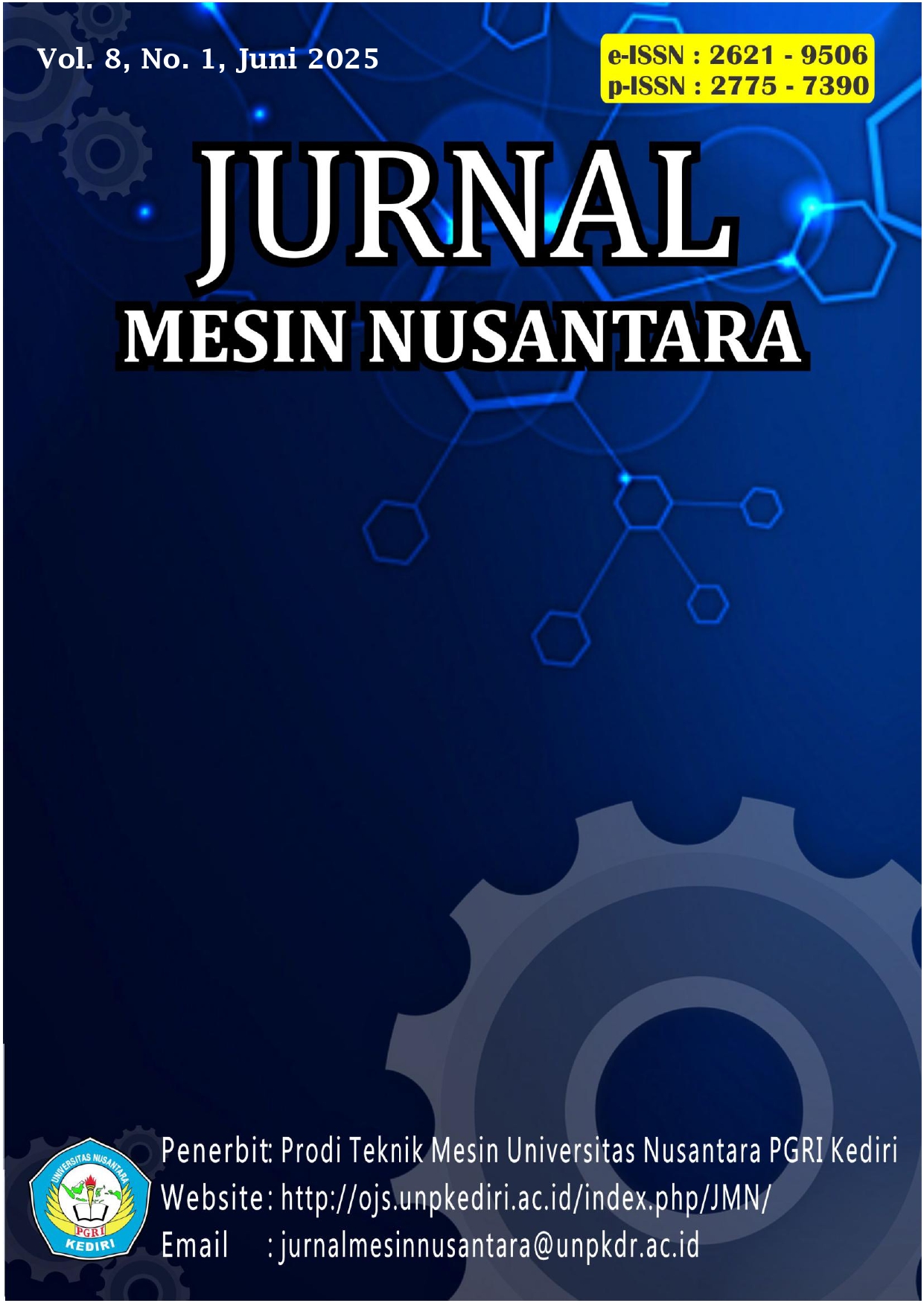Simulasi Computational Fluid Dynamics (CFD) Penambahan Internal Reflektor Pada Solar Still Double Slope
DOI:
https://doi.org/10.29407/jmn.v8i1.22287Keywords:
Computational Fluid Dynamics (CFD), desalinasi, internal reflektor, produktivitas air bersih, solar stillAbstract
Penelitian ini membahas kebutuhan esensial akan air bersih dalam menghadapi krisis air bersih yang disebabkan oleh terbatasnya sumber air tawar dan peningkatan populasi. Proses penyaringan air menjadi solusi utama, dengan desalinasi sebagai metode utama menggunakan energi matahari. Studi ini meneliti penggunaan internal reflektor pada solar still double slope untuk meningkatkan produktivitas air tawar dan efisiensi. Simulasi Computational Fluid Dynamics (CFD) digunakan untuk menganalisis perpindahan panas dan aliran fluida dalam sistem tersebut. Penelitian dilakukan di Laboratorium Komputer, Teknik Mesin, Universitas Widyagama Malang, dengan variasi solar still standart/solar still tanpa reflektor dan solar still dengan penambahan internal refelektor (reflektor utara, reflektor selatan dan double reflektor/reflektor utara-selatan). Analisis CFD dapat dioptimalkan untuk meningkatkan produksi air dengan memeriksa pola distribusi temperatur pada solar still. Pemodelan solar still menggunakan aliran multiphase dengan tiga fase (udara, air, dan uap air). Simulasi ini akan fokus pada temperatur, massa jenis uap, dan kecepatan aliran fluida. Hasil simulasi menunjukkan bahwa penambahan internal reflektor meningkatkan transmisi energi matahari ke pelat penyerap, menghasilkan peningkatan penguapan air dan produksi uap air. Validasi simulasi dengan data eksperimen mengonfirmasi kinerja yang memuaskan. Dengan demikian, penelitian ini menyoroti potensi peningkatan efisiensi solar still dalam memproduksi air bersih menggunakan energi matahari.
Downloads
References
[1] B. Wicaksono, T. Iduwin, D. Mayasari, P. S. Putri, and T. Yuhanah, “Edukasi Alat Penjernih Air Sederhana Sebagai Upaya Pemenuhan Kebutuhan Air Bersih,” Terang, vol. 2, no. 1, pp. 43–52, 2019, doi: 10.33322/terang.v2i1.536.
[2] L. Sahota and G. N. Tiwari, “Review on series connected photovoltaic thermal (PVT) systems: Analytical and experimental studies,” Sol. Energy, vol. 150, pp. 96–127, 2017, doi: 10.1016/j.solener.2017.04.023.
[3] G. H. Cahyana, “Integrasi Pengelolaan Air Minum dan Air Limbah,” 2023.
[4] D. B. Singh and G. N. Tiwari, “Effect of energy matrices on life cycle cost analysis of partially covered photovoltaic compound parabolic concentrator collector active solar distillation system,” Desalination, vol. 397, pp. 75–91, 2016, doi: 10.1016/j.desal.2016.06.021.
[5] P. Suwandono, N. R. Ismail, D. Hermawan, and F. D. Anggraeni, “Simulasi CFD pada Solar Still Double Slope dengan Kolektor Pasir Besi,” JETM, vol. 06, no. 01, pp. 01–06, 2023.
[6] R. Sathyamurthy et al., “A Review of integrating solar collectors to solar still,” Renew. Sustain. Energy Rev., vol. 77, no. November, pp. 1069–1097, 2017, doi: 10.1016/j.rser.2016.11.223.
[7] N. R. Ismail, D. Hermawan, P. Suwandono, and L. H. Wicaksono, “Investigation of Performance of Stone Fin Solar Still Absorber by Water Depth Variations,” vol. 12, no. August, pp. 159–170, 2023, doi: 10.13170/aijst.12.2.27188.
[8] N. R. Ismail, P. Suwandono, D. Hermawan, and F. D. Anggraeni, “Pemanfaatan dinding sebagai permukaan kondensasi untuk meningkatkan kinerja solar still double slope,” Turbo J. Progr. Stud. Tek. Mesin, vol. 12, no. 1, pp. 1–9, 2023.
[9] M. Ridwan, N. R. Ismail, and D. Hermawan, “Pengaruh Kaca Penutup Double Slope dengan Piramida Menggunakan Pelat Penyerap Sirip terhadap Kinerja Solar Still,” vol. 6, no. 2, pp. 107–116, 2023.
[10] M. Afrand, R. Kalbasi, A. Karimipour, and S. Wongwises, “Experimental investigation on a thermal model for a basin solar still with an external reflector,” Energies, vol. 10, no. 1, pp. 1–16, 2017, doi: 10.3390/en10010018.
[11] K. M. Bataineh and M. A. Abbas, “Performance analysis of solar still integrated with internal reflectors and fins,” Sol. Energy, vol. 205, no. February, pp. 22–36, 2020, doi: 10.1016/j.solener.2020.04.059.
[12] Z. M. Omara, A. E. Kabeel, and A. S. Abdullah, “A review of solar still performance with reflectors,” Z.M. Omaraa A.E. Kabeelb A.S. Abdullah, vol. 68, no. October 2016, pp. 638–649, 2017, doi: 10.1016/j.rser.2016.10.031.
[13] V. R. Khare, A. P. Singh, H. Kumar, and R. Khatri, “Modelling and Performance Enhancement of Single Slope Solar Still Using CFD,” Energy Procedia, vol. 109, no. November 2016, pp. 447–455, 2017, doi: 10.1016/j.egypro.2017.03.064.
[14] M. A. Mahdi and A. Smaili, “Numerical investigations of the thermal behavior of a HAWT nacelle using ANSYS FLUENT,” Energy Procedia, vol. 141, pp. 394–398, 2017, doi: 10.1016/j.egypro.2017.11.049.
[15] M. Flores, S. Chávez, H. Terres, A. Lizardi, and A. Lara, “Thermal analysis of a solar still through CFD Thermal analysis of a solar still through CFD,” Conf. Ser., pp. 1–6, 2022, doi: 10.1088/1742-6596/2307/1/012008.
Downloads
Published
Issue
Section
License
Copyright (c) 2025 Nova Risdiyanto Ismail, Rendra Adi Wijaya, Purbo Suwandono

This work is licensed under a Creative Commons Attribution-ShareAlike 4.0 International License.
Authors who publish with this journal agree to the following terms:
- Copyright on any article is retained by the author(s).
- The author grants the journal, right of first publication with the work simultaneously licensed under a Creative Commons Attribution License that allows others to share the work with an acknowledgment of the work’s authorship and initial publication in this journal.
- Authors are able to enter into separate, additional contractual arrangements for the non-exclusive distribution of the journal’s published version of the work (e.g., post it to an institutional repository or publish it in a book), with an acknowledgment of its initial publication in this journal.
- Authors are permitted and encouraged to post their work online (e.g., in institutional repositories or on their website) prior to and during the submission process, as it can lead to productive exchanges, as well as earlier and greater citation of published work.
- The article and any associated published material is distributed under the Creative Commons Attribution-ShareAlike 4.0 International License












